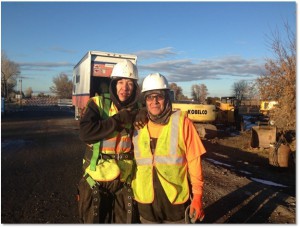Partnering to Promote Workplace Safety and Health in Tribal Communities
Posted on byOver 5.2 million American Indians and Alaska Natives (AI/AN) live across the United States. In 2013, approximately 1,319,000 AI/AN workers were employed in the U.S. workforce1,2. AI/AN workers are 42 percent more likely to be employed in a high-risk occupation (defined as an occupation where the injury and illness rate is more than twice the national average) as compared to non-Hispanic Whites.3 National data on occupational injuries, illnesses and fatalities among AI/AN are scarce and there is limited research on worker safety and health in tribal communities.
NIOSH American Indian/Alaska Native Initiative
In 2013, NIOSH launched an initiative to partner with AI/AN communities, tribal serving organizations, and other stakeholders to provide occupational safety and health support. The main goal of the initiative is to maximize resources to build and strengthen capacity to ensure workers make it home safely to their families in tribal communities. All activities are coordinated with the U.S. Centers for Disease Control and Prevention’s Office for State, Tribal, Local and Territorial Support (OSTLTS).
Tribal Worker Safety and Health Workshop
In August, 2015, NIOSH and the Center for Health, Work and Environment, a Center within the Colorado School of Public Health, convened the first partnership workshop on the occupational safety and health issues of AI/AN workers. Tribal representatives, tribal serving organizations, academia, and state and federal government agencies came together to advance worker safety and health among AI/AN.
Attendees represented 14 states, primarily from the Western United States. Tribal safety and health professionals, tribal epidemiologists, state Health Department representatives and physicians attended. Representatives from the Navajo Nation and Shoshone-Bannock Tribes presented their Tribal occupational safety and health programs. Workshop presentations are available here.
The workshop established new and fostered existing relationships among the many organizations and tribes. Additionally, an AI/AN occupational safety and health network was created to share resources and build capacity.
Partnerships
Ongoing discussions with partners continue to inform how NIOSH can best provide occupational safety and health support to AI/AN communities. Examples of partnerships include:
- Working with the National Indian Health Board (NIHB) to highlight occupational safety and health in Tribal public health though their Annual Tribal Public Health Summit.
- Partnering with stakeholders in Oklahoma to adapt the NIOSH young worker curriculum, Youth@Work–Talking Safety, for Native youth to teach foundational knowledge and skills.
- Collaborating with WeRNative, a comprehensive health resource for Native youth, to develop tailored messages for their target audience.
Moving Forward
NIOSH staff are conducting site visits to tribal locations in different parts of the country to discuss AI/AN worker safety and health. We recently conducted sites visits to the Navajo Nation, the Shoshone-Bannock Tribes and the Oklahoma Tribes. We look forward to site visits to New Mexico and Alaska later this year.
These site visits will further develop partnerships and increase understanding of priorities; activities in tribal communities to enhance their capacity to reduce worker injury, illness and death on the job; and how NIOSH and the occupational safety and health community can contribute to these efforts.
How can you get involved?
NIOSH is interested in partnering with tribes and tribal serving organizations to advance Tribal Worker Safety and Health programs and initiatives and to increase understanding of surveillance in Indian Country. We would like to know:
- What types of Tribal Worker Safety and Health programs and initiatives are active in your community?
- How are tribal worker data reported where you live and work?
NIOSH wants to hear from you!
To learn more and stay connected, join the new NIOSH-NIHB Tribal Occupational Safety and Health listserv. Contact Elizabeth Dalsey at edalsey@cdc.gov to be added to the listserv.
Liz Dalsey is a Health Communication Specialist in the NIOSH Western States Office.
References
1 US Census Bureau http://factfinder.census.gov/faces/tableservices/jsf/pages/productview.xhtml?src=CF
2 US Census Bureau http://www.bls.gov/opub/reports/cps/race_ethnicity_2013.pdf
3 Steege A, Baron S, Marsh S, Menendez C, Myers J [2014]. Examining Occupational Health and Safety Disparities Using National Data: A Cause for Continuing Concern. Am J Ind Med 57:527-538.
4 Hill R, Edgar Reyes, Dalsey E [2013]. NIOSH launches worker safety and health initiative for American Indians and Alaska Natives. IHS Prim Care Provid 38(12): 205-207.
Posted on by


